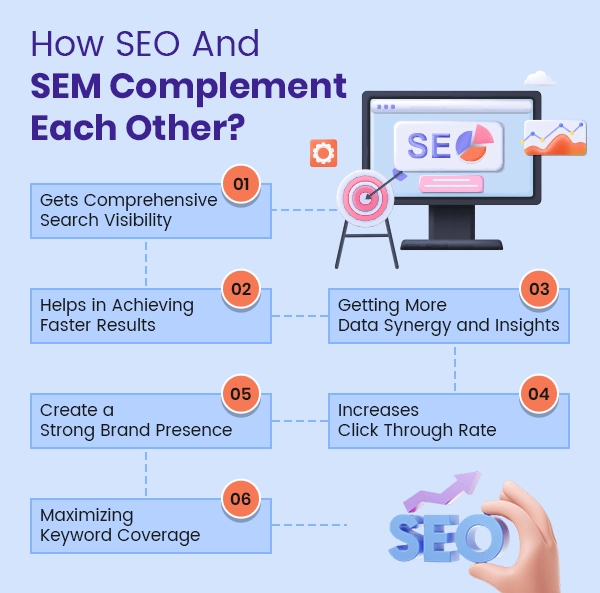
Unlocking the Synergy: Understanding the Relationship Between SEO and SEM
In the ever-evolving landscape of digital marketing, the relationship between SEO (Search Engine Optimization) and SEM (Search Engine Marketing) plays a pivotal role in shaping the success of online businesses. Understanding how these two strategies work together is essential for unlocking their full potential and maximizing the visibility and reach of a website. By delving into the intricacies of this synergy, businesses can optimize their online presence, drive targeted traffic, and ultimately achieve their marketing goals with precision and effectiveness.
Integrating SEO and SEM is crucial for maximizing the visibility and effectiveness of your online marketing efforts. SEO (Search Engine Optimization) focuses on optimizing your website to rank higher in organic search results, while SEM (Search Engine Marketing) involves paid advertising to drive targeted traffic to your site. By combining these two strategies, you can create a powerful online presence that reaches a wider audience and drives more traffic to your website.
One key benefit of integrating SEO and SEM is that they work together to enhance your overall search engine visibility. While SEO helps improve your organic search rankings over time, SEM allows you to quickly target specific keywords and reach potential customers through paid ads. By aligning your SEO and SEM strategies, you can ensure that your website appears in both organic and paid search results, increasing your chances of attracting valuable traffic.
Moreover, integrating SEO and SEM can also help you gain valuable insights into your target audience’s behavior and preferences. By analyzing the data from both organic and paid search campaigns, you can identify trends, optimize your content, and refine your keyword strategy to better meet the needs of your audience. This holistic approach to search engine marketing not only boosts your online visibility but also helps you better understand and connect with your target customers.
SEO (Search Engine Optimization) and SEM (Search Engine Marketing) are two powerful digital marketing strategies that work hand in hand to boost a website’s visibility and drive traffic. While SEO focuses on improving a website’s organic search rankings through content optimization, link building, and keyword research, SEM involves paid advertising to increase a website’s visibility on search engine results pages.
By combining SEO and SEM, businesses can achieve maximum online visibility and reach their target audience effectively. SEO lays a strong foundation for a website by optimizing its content and structure, making it easier for search engines to crawl and index the site. On the other hand, SEM provides immediate visibility through paid ads, allowing businesses to target specific keywords and reach potential customers who are actively searching for relevant products or services.
In essence, SEO and SEM work together to enhance a website’s online presence. SEO helps to build long-term sustainable traffic through organic search results, while SEM provides immediate visibility through paid advertising. By integrating both strategies, businesses can maximize their online visibility and drive targeted traffic to their website, ultimately leading to increased leads, conversions, and revenue.
Maximizing results through a combined strategy of Search Engine Optimization (SEO) and Search Engine Marketing (SEM) is essential for businesses looking to enhance their online presence and drive more traffic to their websites. By effectively integrating SEO and SEM tactics, businesses can increase their visibility on search engine results pages and attract more potential customers.
SEO focuses on optimizing a website’s content and structure to improve organic search rankings, while SEM involves paid advertising campaigns to drive targeted traffic to a website. When these two strategies are used together, businesses can benefit from increased brand visibility, higher website traffic, and improved conversion rates.
By leveraging the strengths of both SEO and SEM, businesses can create a powerful online marketing strategy that maximizes their reach and drives measurable results. This integrated approach allows businesses to target specific keywords, reach a wider audience, and ultimately achieve their online marketing goals.
Leveraging keywords is crucial for achieving success in both SEO and SEM strategies. By identifying and incorporating relevant keywords into your website content, you can increase your visibility on search engines and attract more potential customers. In SEO, optimizing your website with these keywords helps improve your organic search ranking, making it easier for users to find you when they search for related terms. On the other hand, in SEM campaigns, using the right keywords in your ad copy can help target your ads to the right audience, leading to higher click-through rates and conversions.
To maximize the impact of your keyword strategy, it’s important to conduct thorough keyword research to uncover high-performing keywords that align with your business goals. By understanding the search behavior of your target audience and incorporating these keywords strategically throughout your website and ad campaigns, you can boost your online visibility and drive more traffic to your site. Additionally, regularly monitoring and optimizing your keyword performance can help you stay ahead of the competition and continuously improve your SEO and SEM efforts for long-term success.
Monitoring performance is crucial when it comes to maximizing the effectiveness of your SEO and SEM strategies. By tracking key metrics such as website traffic, keyword rankings, click-through rates, and conversion rates, you can gain valuable insights into how well your campaigns are performing and make informed decisions to drive better results.
Regularly monitoring these metrics allows you to identify trends, measure the impact of your efforts, and make adjustments to optimize your strategies for success. By staying on top of your SEO and SEM performance data, you can ensure that your online presence is continuously improving and attracting more relevant traffic to your website. Remember, consistent monitoring and analysis of these metrics are essential for achieving long-term success in the competitive online landscape.
Content plays a crucial role in both SEO and SEM campaigns, as it is the foundation on which search engines base their rankings. In the realm of SEO, high-quality and relevant content can help websites rank higher in search engine results pages (SERPs) by providing valuable information to users and demonstrating expertise in a particular topic. This, in turn, can increase organic traffic to a website and improve its overall visibility online.
Similarly, in SEM campaigns, content is essential for creating compelling ads and landing pages that entice users to click and engage with a website. By incorporating relevant keywords and optimizing content for search engines, businesses can improve their ad quality scores and increase the likelihood of their ads being displayed to a targeted audience. Additionally, engaging and informative content can help drive conversions by guiding users through the sales funnel and encouraging them to take desired actions on a website. In essence, content is the backbone of successful SEO and SEM campaigns, helping businesses attract and retain customers while boosting their online presence.
Budget allocation is a crucial aspect of digital marketing strategy, especially when it comes to balancing investment in search engine optimization (SEO) and search engine marketing (SEM). Both SEO and SEM play vital roles in driving traffic to your website, but understanding how to allocate your budget effectively can maximize your results.
SEO involves optimizing your website content to improve its visibility in organic search results. Investing in SEO can help you rank higher on search engine result pages, which can lead to increased organic traffic and long-term sustainability. On the other hand, SEM involves paying for advertising space on search engines to drive immediate traffic to your website. By allocating your budget strategically between SEO and SEM, you can leverage the strengths of both strategies to achieve a balanced online presence.
When deciding how to allocate your budget between SEO and SEM, consider your business goals, target audience, and competition. Investing in both SEO and SEM can help you reach a wider audience and drive more traffic to your website. By finding the right balance between the two strategies, you can optimize your online visibility and improve your overall digital marketing performance.
Understanding user intent is crucial in both SEO and SEM optimization. User intent refers to the reason behind a search query, what the user is looking for, and their ultimate goal. By understanding user intent, businesses can create content that meets the needs of their target audience and provides valuable information.
In SEO, optimizing for user intent involves conducting keyword research to identify the phrases and terms that users are searching for. By incorporating these keywords naturally into website content, businesses can improve their chances of ranking higher in search engine results. In SEM, understanding user intent helps businesses create more targeted ad campaigns that reach users who are actively seeking their products or services.
By focusing on user intent in both SEO and SEM optimization strategies, businesses can attract more relevant traffic to their websites, increase engagement, and ultimately drive conversions. It’s all about providing the right information to the right people at the right time.
Adapting to algorithm changes is crucial for maintaining a strong online presence. Search Engine Optimization (SEO) and Search Engine Marketing (SEM) are key strategies in ensuring visibility and driving traffic to your website. Best practices in SEO involve optimizing website content, meta tags, and internal linking to align with search engine algorithms. Meanwhile, SEM focuses on paid advertising campaigns to increase website visibility on search engine result pages.
To adapt effectively to algorithm changes, it is important to stay informed about updates from search engines and continuously monitor website performance. Implementing relevant keywords, creating high-quality content, and improving user experience are essential for SEO success. Similarly, SEM strategies should be regularly reviewed and optimized to maximize ROI and reach the target audience. By combining SEO and SEM best practices, businesses can enhance their online presence and stay competitive in the digital landscape.
Successful integration of SEO and SEM strategies can greatly enhance a business’s online visibility and drive more targeted traffic to their website. By combining the power of search engine optimization (SEO) and search engine marketing (SEM), businesses can maximize their online presence and attract more potential customers.
One case study that highlights the benefits of integrating SEO and SEM strategies is a local bakery that saw a significant increase in website traffic and online orders after implementing a cohesive approach. By optimizing their website for relevant keywords using SEO techniques and running targeted Google Ads campaigns through SEM, the bakery was able to reach a larger audience and increase their online sales.
In conclusion, the synergy between SEO and SEM can be a game-changer for businesses looking to improve their online visibility and drive more traffic to their website. By strategically combining these two digital marketing strategies, businesses can achieve higher search engine rankings, attract more qualified leads, and ultimately boost their online revenue.




